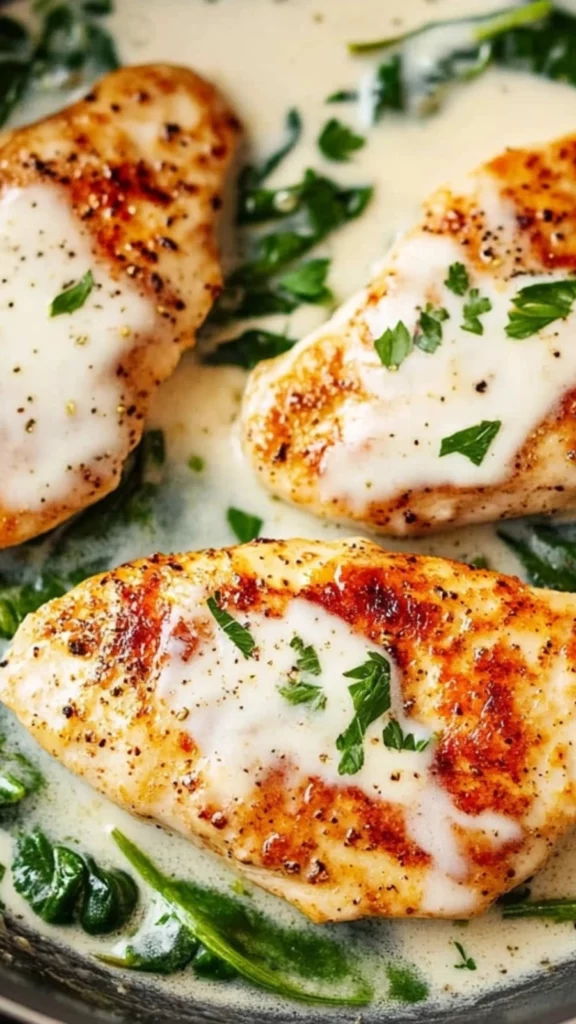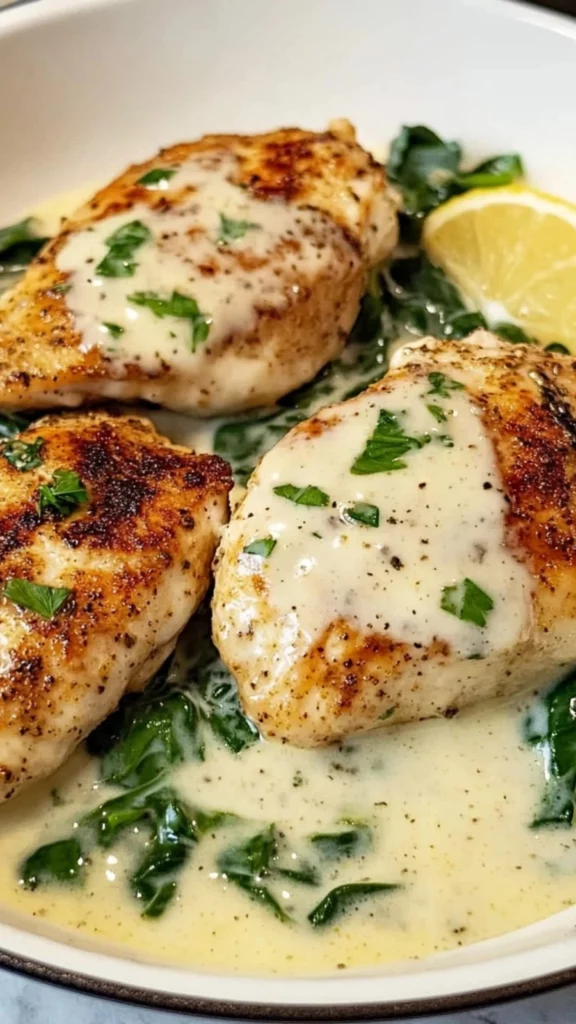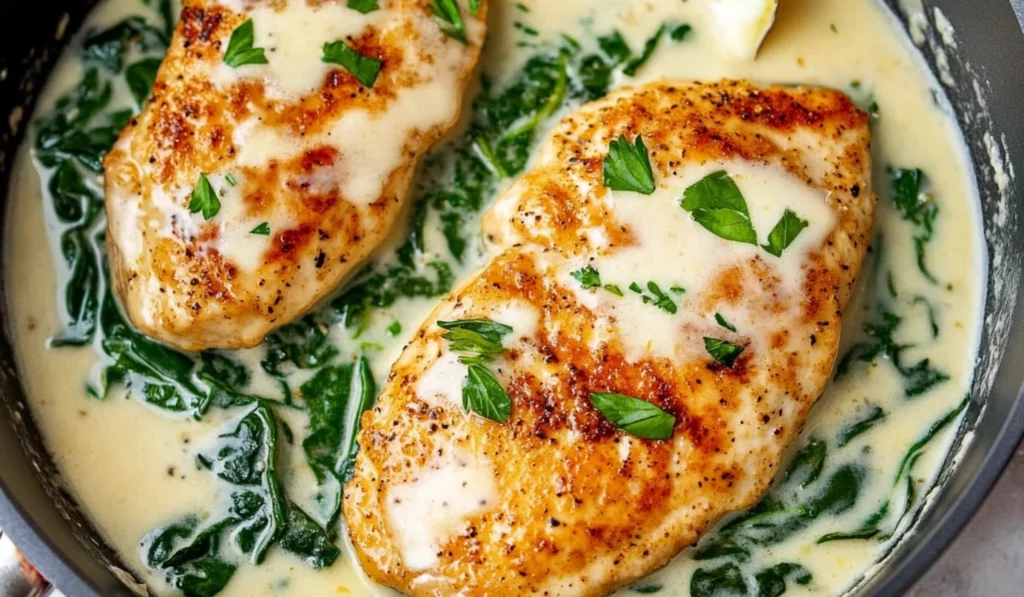Imagine sinking your fork into perfectly seared chicken, nestled in a rich, creamy spinach sauce that bursts with flavor. This Chicken Florentine recipe is a culinary hug, a comforting dish that’s surprisingly easy to make. I remember the first time I made this. I was looking for a dish that felt special but didn’t require advanced culinary skills. I stumbled upon a simple Chicken Florentine recipe, and I was amazed at how quickly it came together. The aroma of garlic, white wine, and creamy spinach filled my kitchen, and the chicken turned out incredibly tender. It was an instant hit with my family, and it’s become a go-to for those nights when I want a satisfying and elegant meal without the fuss. This Chicken Florentine is a testament to the fact that you don’t need to be a seasoned chef to create a restaurant-quality dish. It’s a relatively quick and easy recipe that’s ideal for beginner cooks. It’s ready in just 45 minutes and uses readily available ingredients and straightforward cooking techniques. Plus, it’s a fantastic way to learn how to sear chicken, make a creamy sauce, and incorporate leafy greens into your meals.

Chicken Florentine: A Creamy Spinach Delight
This Chicken Florentine recipe has perfectly seared chicken in a thick and creamy spinach sauce. Serve it with pasta, rice, or with a simple green salad. Add a splash of lemon and a sprinkle of parsley for added flavor and color!
- Prep Time: 20 minutes
- Cook Time: 25 minutes
- Total Time: 45 minutes
- Yield: 4 servings 1x
- Category: Main Course, Dinner
- Method: Sautéing, Pan-frying
- Cuisine: Italian, American
Ingredients
- 4 boneless skinless chicken breasts
- 2 Tablespoons olive oil
- 2 Tablespoons Butter
- 1 teaspoon salt
- ½ teaspoon pepper
- 2 teaspoons Italian Seasoning
- ½ cup flour
- ¼ cup Parmesan cheese, finely shredded
- 1 teaspoon garlic powder
- 4 cloves garlic, minced
- 1 ½ cups white wine, or chicken broth
- 1 cup half and half
- 1/3 cup softened cream cheese
- 3 cups fresh spinach
- 1/2 fresh lemon or 1.5 tablespoons lemon juice
- Fresh parsley, to garnish
Instructions
- Prepare the Chicken: Place saran wrap over each chicken breast and use a meat tenderizer to pound it until it’s about 1/2-inch thick and of equal thickness throughout. Pat dry. Pounding the chicken ensures even cooking and tenderizes the meat.
- Prepare the Chicken Dredge: Combine the chicken dredge ingredients in a shallow dish. Combining the ingredients ensures even distribution of flavor.
- Coat the Chicken: Coat the chicken in the flour mixture, tap off any excess. Tapping off excess flour prevents the dredge from becoming too thick.
- Sear the Chicken: Melt the butter and olive oil in a skillet over medium-high heat. Add the chicken and cover the pan. Cook for 4-5 minutes per side, until golden. If needed, sear in 2 separate batches. Set aside on a plate once cooked, it’s done when the internal temperature reaches 165 degrees. Searing the chicken creates a golden crust and ensures it is cooked through.
- Sauté the Garlic: Decrease heat to medium and add the garlic. Cook for 1 minute. Sautéing the garlic releases its flavor.
- Deglaze the Pan: Add the white wine and deglaze the pan by running a silicone spatula on the bottom to scrape up the brown bits from the pan. This gives the sauce plenty of flavor. Increase heat slightly and allow it to gently bubble until the liquid is reduced by half, about 5 minutes. Deglazing the pan adds depth of flavor to the sauce.
- Temper the Half and Half: Temper the half and half by heating in the microwave for 40 seconds. Add it to the skillet in splashes, stirring as you do so. Bring it to a gentle bubble, then reduce heat to low. Tempering the half and half prevents it from curdling.
- Add the Cream Cheese: Stir in the softened cream cheese until smooth and combined. Adding softened cream cheese ensures a smooth sauce.
- Add the Spinach: Add spinach until it’s soft and wilted. Add lemon juice if desired. Adding spinach at the end prevents it from becoming overcooked.
- Return the Chicken: Return the chicken & any drippings back to the pan. Cover to heat through. Sprinkle with parsley and serve! Returning the chicken to the sauce allows it to absorb the flavors.
Notes
- Pound chicken for even cooking.
- Tap off excess flour.
- Use a meat thermometer.
- Temper half and half to prevent curdling.
Ingredients and Preparation: The Building Blocks of Flavor
This Chicken Florentine uses a combination of tender chicken breasts, a flavorful dredge, and a creamy spinach sauce, creating a delightful balance of textures and flavors.
- The Chicken Base:
- 4 boneless skinless chicken breasts – Boneless skinless chicken breasts are the perfect choice for this recipe. They are lean, cook quickly, and absorb the flavors of the sauce beautifully.
- 2 Tablespoons olive oil – Olive oil is used for searing the chicken, adding flavor and preventing sticking.
- 2 Tablespoons butter – Butter adds richness and flavor to the searing process.
- The Chicken Dredge:
- 1 teaspoon salt – Salt enhances the flavors of the chicken and the dredge.
- ½ teaspoon pepper – Pepper adds a pungent and spicy kick to the dredge.
- 2 teaspoons Italian Seasoning – Italian seasoning adds a blend of herbs that complements the flavors of the dish.
- ½ cup flour – Flour creates a light coating on the chicken, helping it to brown and thicken the sauce.
- ¼ cup Parmesan cheese, finely shredded – Parmesan cheese adds a savory and nutty flavor to the dredge.
- 1 teaspoon garlic powder – Garlic powder adds a concentrated garlic flavor to the dredge.
- The Florentine Sauce:
- 4 cloves garlic, minced – Minced garlic adds a pungent and savory flavor to the sauce.
- 1 ½ cups white wine, or chicken broth – White wine adds a bright and acidic flavor to the sauce. Chicken broth is a non-alcoholic alternative.
- 1 cup half and half – Half and half adds creaminess and richness to the sauce.
- 1/3 cup softened cream cheese – Softened cream cheese adds a smooth and creamy texture to the sauce.
- 3 cups fresh spinach – Fresh spinach adds a vibrant green color and a mild, earthy flavor to the sauce.
- 1/2 fresh lemon or 1.5 tablespoons lemon juice, optional – Lemon juice adds a bright and citrusy flavor to the sauce.
- Fresh parsley, to garnish – Fresh parsley adds a pop of color and a fresh, herbaceous flavor to the dish.
Step-by-Step Instructions: From Prep to Plate
This recipe is broken down into easy-to-follow steps, making it perfect for even the most beginner cook.
- Prepare the Chicken: Place saran wrap over each chicken breast and use a meat tenderizer to pound it until it’s about 1/2-inch thick and of equal thickness throughout. Pat dry. Pounding the chicken ensures even cooking and tenderizes the meat.
- Prepare the Chicken Dredge: Combine the chicken dredge ingredients in a shallow dish. Combining the ingredients ensures even distribution of flavor.
- Coat the Chicken: Coat the chicken in the flour mixture, tap off any excess. Tapping off excess flour prevents the dredge from becoming too thick.
- Sear the Chicken: Melt the butter and olive oil in a skillet over medium-high heat. Add the chicken and cover the pan. Cook for 4-5 minutes per side, until golden. If needed, sear in 2 separate batches. Set aside on a plate once cooked, it’s done when the internal temperature reaches 165 degrees. Searing the chicken creates a golden crust and ensures it is cooked through.
- Sauté the Garlic: Decrease heat to medium and add the garlic. Cook for 1 minute. Sautéing the garlic releases its flavor.
- Deglaze the Pan: Add the white wine and deglaze the pan by running a silicone spatula on the bottom to scrape up the brown bits from the pan. This gives the sauce plenty of flavor. Increase heat slightly and allow it to gently bubble until the liquid is reduced by half, about 5 minutes. Deglazing the pan adds depth of flavor to the sauce.
- Temper the Half and Half: Temper the half and half by heating in the microwave for 40 seconds. Add it to the skillet in splashes, stirring as you do so. Bring it to a gentle bubble, then reduce heat to low. Tempering the half and half prevents it from curdling.
- Add the Cream Cheese: Stir in the softened cream cheese until smooth and combined. Adding softened cream cheese ensures a smooth sauce.
- Add the Spinach: Add spinach until it’s soft and wilted. Add lemon juice if desired. Adding spinach at the end prevents it from becoming overcooked.
- Return the Chicken: Return the chicken & any drippings back to the pan. Cover to heat through. Sprinkle with parsley and serve! Returning the chicken to the sauce allows it to absorb the flavors.
Beginner Tips and Notes: Your Culinary Companion
Here are some helpful tips and notes for beginner cooks to ensure success with this Chicken Florentine:
- Chicken Thickness: Pounding the chicken to an even thickness ensures even cooking. Even thickness means even cooking.
- Dredge Coating: Tap off any excess flour mixture to prevent a thick coating. Excess flour creates a thick coating.
- Searing Technique: Sear the chicken over medium-high heat to create a golden crust. Medium-high heat creates a golden crust.
- Chicken Doneness: Use a meat thermometer to ensure that the chicken is cooked through. The internal temperature should reach 165°F (74°C). A meat thermometer ensures proper doneness.
Serving Suggestions: Completing the Meal
This Chicken Florentine is a versatile dish that can be served with a variety of sides.
- Pasta: Serve the chicken florentine with your favorite pasta, such as linguine, fettuccine, or penne. Pasta soaks up the creamy sauce.
- Rice: Serve the chicken florentine with steamed rice or risotto. Rice is a classic side.
- Mashed Potatoes: Serve the chicken florentine with mashed potatoes for a comforting meal. Mashed potatoes add creaminess.
Variations and Adaptations: Making it Your Own
One of the best things about this Chicken Florentine recipe is its versatility. It’s easy to adapt to your own tastes and preferences, allowing you to create a dish that’s truly your own. Here are some ideas for variations and adaptations:
- Mushroom Florentine: Add sliced mushrooms to the sauce for a richer flavor.
- Sun-Dried Tomato Florentine: Add sun-dried tomatoes to the sauce for a tangy and flavorful twist.
- Artichoke Florentine: Add artichoke hearts to the sauce for a Mediterranean flair.
- Spicy Florentine: Add a pinch of red pepper flakes or a dash of hot sauce to the sauce for a spicy kick.
Troubleshooting Tips: Overcoming Culinary Challenges
Even the most experienced cooks encounter occasional mishaps in the kitchen. Here are some troubleshooting tips to help you overcome common culinary challenges:
- Chicken is Dry: If your chicken is dry, it’s likely that you overcooked it. Be sure to use a meat thermometer to check the internal temperature and avoid overcooking.
- Sauce is Too Thin: If your sauce is too thin, you can thicken it by simmering it for a few more minutes to reduce it. You can also add a slurry of corn starch and water to thicken it.
- Sauce is Too Thick: If your sauce is too thick, you can thin it by adding a little chicken broth or half and half.
- Sauce is Curdled: If your sauce is curdled, it’s likely that you added the half and half or cream cheese too quickly. Be sure to temper the half and half before adding it to the skillet and use softened cream cheese.
- Spinach is Overcooked: If your spinach is overcooked, it will be mushy and lose its vibrant green color. Add the spinach at the end and cook until it is just wilted.

Conclusion: A Florentine Feast
This Chicken Florentine is a fun, easy, and delicious way to enjoy a creamy and flavorful meal. It’s perfect for beginner cooks, it’s adaptable to your taste, and it’s sure to be a hit with your family and friends. I encourage you to try this recipe and make it your own! Experiment with different vegetables, spices, and cheeses to create your perfect Chicken Florentine. Don’t be afraid to get creative in the kitchen and have some fun! Cooking should be an enjoyable experience, a chance to explore new flavors and create delicious meals that you can share with your loved ones. This recipe is a great starting point for building your culinary confidence and discovering your own unique cooking style. And remember, a simple dish can be incredibly satisfying!
Now, I’d love to hear from you! Did you try this recipe? What did you think? Did you make any modifications? What ingredients did you use? Share your photos and experiences in the comments below! Happy cooking, and happy eating!




